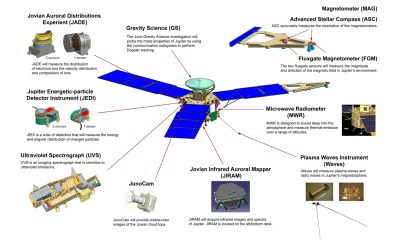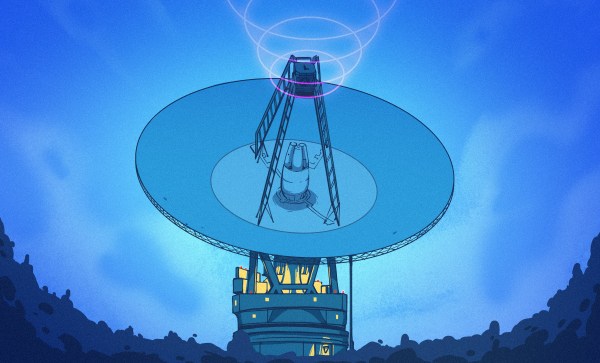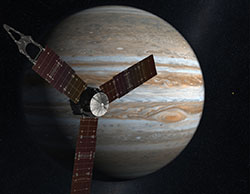We’ve probably all seen some old newsreel or documentary from The Before Times where the narrator, using his best Mid-Atlantic accent, described those newfangled computers as “thinking machines,” or better yet, “electronic brains.” It was an apt description, at least considering that the intended audience had no other frame of reference at a time when the most complex machine they were familiar with was a telephone. But what if the whole “brain” thing could be taken more literally? We’ll have to figure that out soon if these computers powered by miniature human brains end up getting any traction.
Juno7 Articles
Annealing In Space: How NASA Saved JunoCam In Orbit Around Jupiter
The Juno spacecraft was launched towards Jupiter in August of 2011 as part of the New Frontiers series of spacecraft, on what would originally have been a 7-year mission, including a nearly 5 year cruise to the planet. After a mission extension, it’s currently orbiting Jupiter, allowing for many more years of scientific data to be gathered using its instruments. One of these instruments is the JunoCam (JCM), a visible light camera and telescope. Unfortunately the harsh radiation environment around Jupiter had led many to believe that this camera would fail before long. Now it seems that NASA engineers have successfully tested a fix.

Although the radiation damage to JCM was obvious a few dozen orbits in – and well past its original mission’s 34 orbits – the big question was exactly what was being damaged by the radiation, and whether something could be done to circumvent or fix it. The good news was that the image sensor itself was fine, but one of the voltage regulators in JCM’s power supply was having a bad time. This led the engineers to try annealing the affected part by cranking up one of the JCM’s heaters to a balmy 25°C, well above what it normally is kept at.
This desperate step seemed to work, with massively improved image quality on the following orbits, but soon the images began to degrade again. Before an approach to Jupiter’s moon Io, the engineers thus tried it again but this time cranked the JCM’s heater up to eleven and crossed their fingers. Surprisingly this fixed the issue over the course of a week, until the JCM seems as good as new. Now the engineers are trying their luck with Juno‘s other instruments as well, with it potentially providing a blueprint for extending the life of spacecraft in general.
Thanks to [Mark Stevens] for the tip.
Supercon 2023: Receiving Microwave Signals From Deep-Space Probes
Here’s the thing about radio signals. There is wild and interesting stuff just getting beamed around all over the place. Phrased another way, there are beautiful signals everywhere for those with ears to listen. We go about our lives oblivious to most of them, but some dedicate their time to teasing out and capturing these transmissions.
David Prutchi is one such person. He’s a ham radio enthusiast that dabbles in receiving microwave signals sent from probes in deep space. What’s even better is that he came down to Supercon 2023 to tell us all about how it’s done!
Continue reading “Supercon 2023: Receiving Microwave Signals From Deep-Space Probes”
Serious DX: The Deep Space Network
Humanity has been a spacefaring species for barely sixty years now. In that brief time, we’ve fairly mastered the business of putting objects into orbit around the Earth, and done so with such gusto that a cloud of both useful and useless objects now surrounds us. Communicating with satellites in Earth orbit is almost trivial; your phone is probably listening to at least half a dozen geosynchronous GPS birds right now, and any ham radio operator can chat with the astronauts aboard the ISS with nothing more that a $30 handy-talkie and a homemade antenna.
But once our spacecraft get much beyond geosynchronous orbit, communications get a little dicier. The inverse square law and the limited power budget available to most interplanetary craft exact a toll on how much RF energy can be sent back home. And yet the science of these missions demands a reliable connection with enough bandwidth to both control the spacecraft and to retrieve its precious cargo of data. That requires a powerful radio network with some mighty big ears, but as we’ll see, NASA isn’t the only one listening to what’s happening out in deep space. Continue reading “Serious DX: The Deep Space Network”
Hackaday Links: July 3, 2016
This week, Popular Mechanics published cutaway diagrams of ships that will be seen in Star Trek: Beyond, released later this month. This is your cue for spoilers for the remainder of this paragraph. The USS Franklin looks suspiciously like – and was likely built after – the NX-01, the titular ship of Star Trek: Enterprise. The Abrams-verse Franklin was the first Warp 4 ship, yet the prime universe NX-01 was the first Warp 5 ship, with previous ships having trouble reaching Warp 2. We must now consider the Abrams-verse Trek is not a parallel universe to prime-universe Trek and should therefore be considered a completely separate canon (yes, even the destruction of Vulcan. If you see the new Star Trek movie, the NX-01 launched in 2151, and your suggested viewing beforehand is ST:ENT, S02E24, First Flight.
The Mechaduino is a Hackaday Prize entry that turns steppers into closed-loop servos. It’s a phenomenal idea, and now it’s a Kickstarter.
Walk into a dollar store, and you’ll find stupid solar powered electronic flower pots. They’re bits of plastic that shake a plastic flower back and forth when placed in the sun. They’re selling millions, and I have no idea why. [Scott] put a jolly wrencher on one of these flower pots. Really, this is just an exercise in 3D printing, but [Scott] printed the jolly wrencher. We don’t see a lot of that, due to how difficult it is to render the wrencher in OpenSCAD.
In just a few hours, Juno will perform an insertion burn around Jupiter. Does this mean pretty pictures? Not quite yet. This is the closest a spacecraft has ever gotten to Jupiter, and over thirty or forty orbits, Juno will fly between Jupiter’s massive radiation belts. Here’s the NASA trailer.
This video recently caught the Internet’s attention. It’s squares and circles that when put next to a mirror look like circles and squares. Yes, it’s weird. People have 3D printers, so of course these ambiguous objects were quickly reverse engineered and printed. Here’s how they work
It looks like Brexit has caught up to Mouser. Here’s their country select dialog for eu.mouser.com. Thanks [Tom] for the screencap.
Upgrading Old Synths To OLED
Roland’s Alpha Juno 2 is an analog, polyphonic synth made in the mid-80s. While it isn’t as capable as the massive synths made around that time, it was very influential synth for the techno scenes of the late 80s and early 90s.
[Jeroen] is lucky enough to have one of these synths, but like all equipment of this era, it’s showing its age. He wanted to replace the character LCD in his Alpha Juno 2 with an OLED display. The original character LCD was compatible with the Hitachi HD44780 protocol, and still today OLEDs can speak this format. What should have been an easy mod turned into editing hex values on the EEPROM, but he still got it to work.
While the original character LCD could display one line of 16 characters, the ROM in the synth didn’t know this. Instead, the display was organized as a 2×8 display in software, with line one starting at address 0h, and line two starting at 40h. For a drop-in replacement, [Jeroen] would need a display the characters organized in this weird 2×8 format. None exist, but he does have a hex editor and an EEPROM burner.
With the Alpha Juno’s firmware in hand thanks to someone who does a few firmware hacks to this synth, [Jeroen] had everything he needed. All that was left to do was going through the code and replace all the references to the second line of the character LCD.
After burning and installing the new ROM, the OLED display was a drop-in replacement. That meant getting rid of the whiney EL backlight in the original display, and making everything nice and glowy for a few nights on a dark stage.
Hackaday 10th Anniversary: Hacking Your Way To NASA
[Steve] drives spacecraft for a living. As an engineer at the Jet Propulsion Laboratory, he’s guided probes to comets, asteroids, Mars, and Jupiter, figured out what happens when telemetry from these probes starts looking weird, and fills the role of the Space Hippy whenever NASA needs some unofficial PR.
Like most people who are impossibly cool, [Steve]’s career isn’t something he actively pursued since childhood. Rather, it’s something that fell in his lap. With qualifications like building a robotic computer to typewriter interface, a custom in-car navigation system in the late 80s, and a lot of work with an Amiga, we can see where [Steve] got his skills.
The earliest ‘hack’ [Steve] can remember was just that – an ugly, poorly welded sidecar for his bicycle made in his early teens. From there, he graduated to Lasertag landmines, Tesla coils, and building camera rigs, including a little bit of work on Octopussy, and a rig for a Miata. It helps when your dad is a cinematographer, it seems.
In college, [Steve] used his experience with 6502 assembler to create one of the first computerized lighting controllers (pre-DMX). After reading a biography on [Buzz Aldrin], [Steve] realized doing his thesis on orbital rendezvous would at least be interesting, if not an exceptionally good way to get the attention of NASA.
Around this time, [Steve] ran into an engineering firm that was developing, ‘something like Mathematica’ for the Apple II, and knowing 6502 assembly got him in the door. This company was also working to get the GPS constellation up and running, and [Steve]’s thesis on orbital mechanics eventually got him a job at JPL.
There’s several lifetimes worth of hacks and builds [Steve] went over at the end of his talk. The highlights include a C64 navigation system for a VW bug, a water drop high voltage machine, and a video editing system built from a few optical encoders. This experience with hacking and modding has served him well at work, too: when the star sensor for Deep Space 1 failed, [Steve] and his coworkers used the science camera as a stand in navigation aid.
One final note: Yes, I asked [Steve] if he played Kerbal Space Program. He’s heard of it, but hasn’t spent much time in it. He was impressed with it, though, and we’ll get a video of him flying around the Jool system eventually.

















